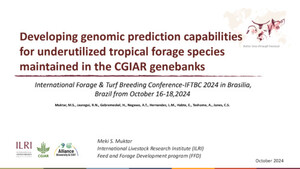
In the search for low-cost year-round feeds: Pen-level growth performance of local and crossbred Ugandan pigs fed forage- or silage-based diets versus commercial diet
Abstract
Smallholder pig farmers in East Africa report that lack of feed, seasonal feed shortages, quality and cost are key constraints to pig rearing. Commercially prepared pig diets are too expensive and people and pigs compete for food. Smallholder farmers typically feed nutritionally unbalanced diets, resulting in low average daily gain (ADG) and poor farmer profits. Our objective was to compare the ADG of Ugandan pigs fed forage- or silage-based or commercial diets. Ugandan weaner-grower pigs were randomly assigned to forage- or silage-based diets or commercial diet. Pigs were weighed every 3 weeks from 9 to 32 weeks of age. Pen-level ADG and feed conversion were compared across diets using multiple linear regression. The ADG of pigs fed forage- or silage-based diets was lower than those fed commercial diets between 9 and 24 weeks of age (p < 0.05). Between 28 and 32 weeks, pigs fed forage-based diets had lower ADG than those on other diets (p < 0.05). Least squares mean ADG (g/pig/day) for pigs fed forage- or silage-based diets or commercial diet were 36, and 52, and 294 respectively at 9–15 weeks; 163, 212, 329 at 15–19 weeks; 112, 362, 574 at 20–24 weeks and 694, 994, and 1233 at 28 to 32 weeks of age. It was concluded that forage- and silage-based diets are unsuitable for small, newly weaned pigs. Feeding forage- or silage-based diets to finishing pigs is more suitable. Forage- and silage based diets are year-round low-cost pig-feeding strategies that will improve the growth performance of East African pigs, thereby increasing pig farmer income and food security.
Citation
Carter, N.A., Dewey, C.E., Grace, D., Lukuyu, B., Smith, E. and Lange, C. de. 2018. In the search for low-cost year-round feeds: Pen-level growth performance of local and crossbred Ugandan pigs fed forage- or silage-based diets versus commercial diet. Journal of Agriculture and Rural Development in the Tropics and Subtropics 119(2): 23–29.









